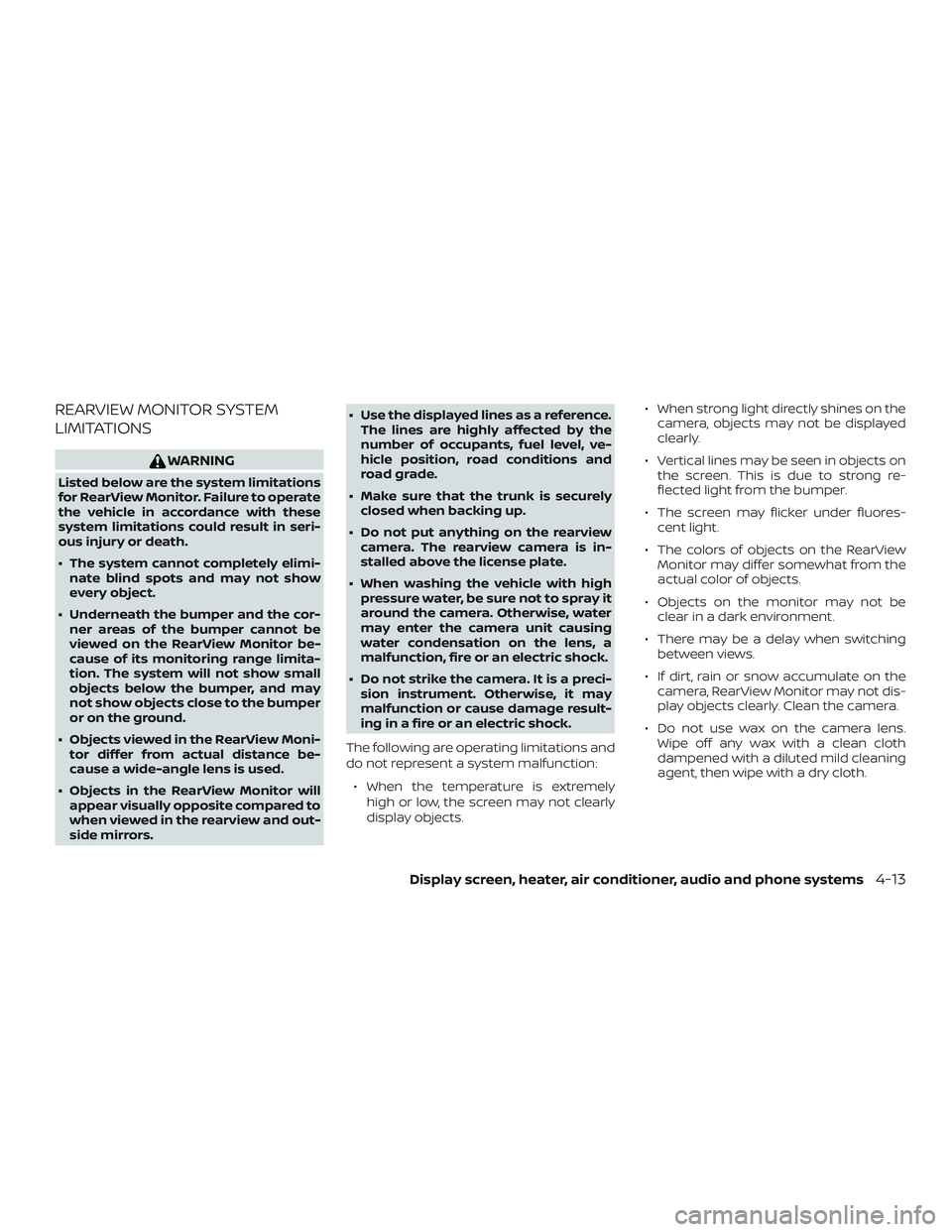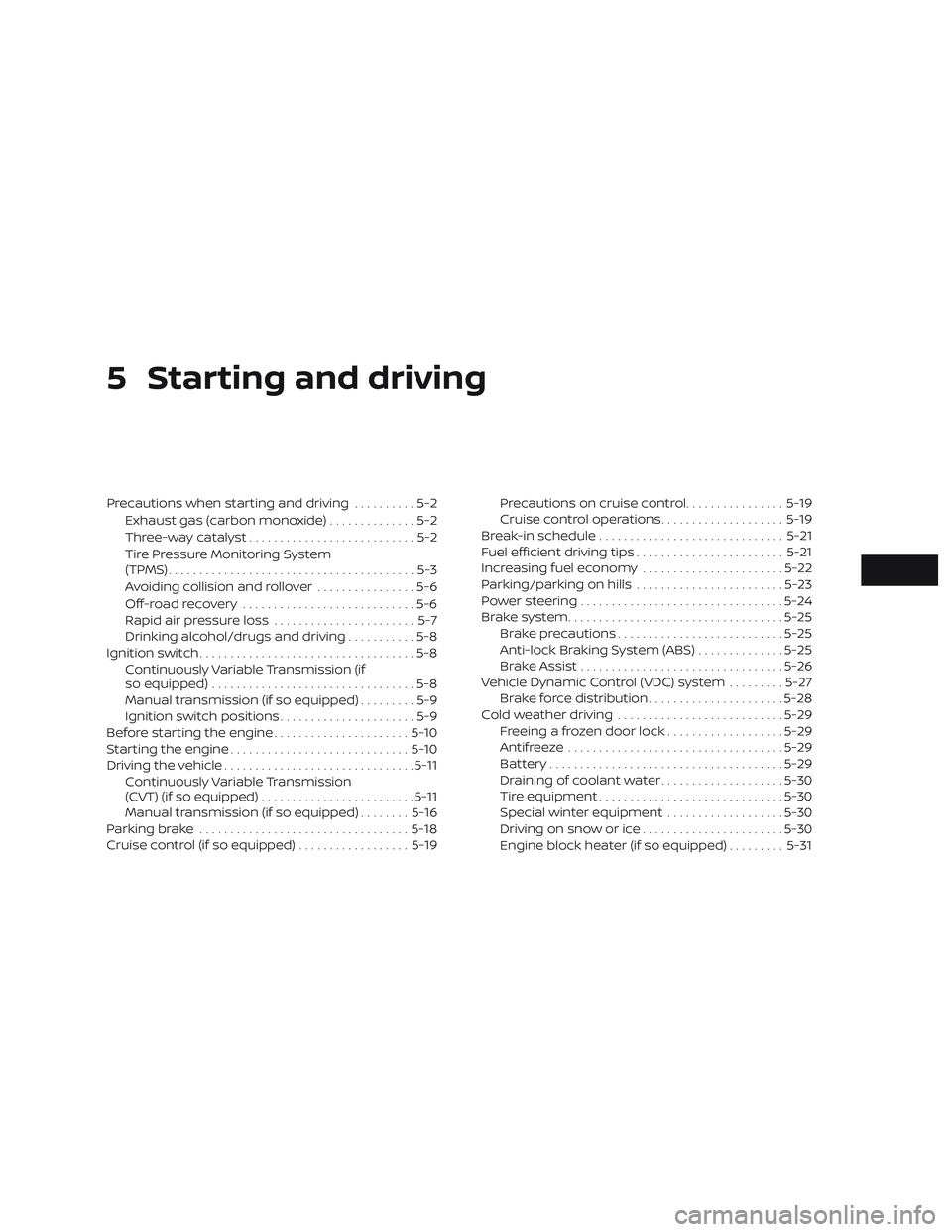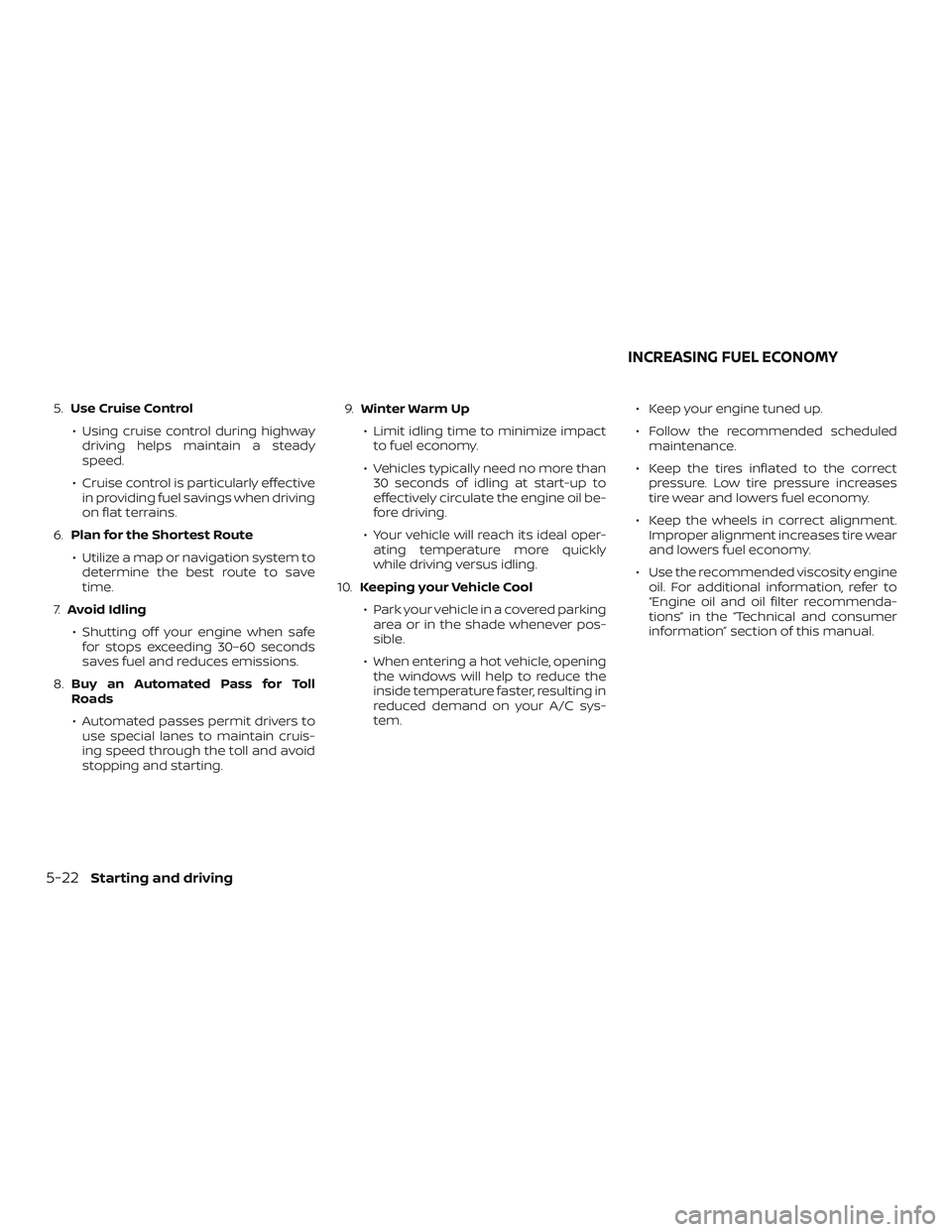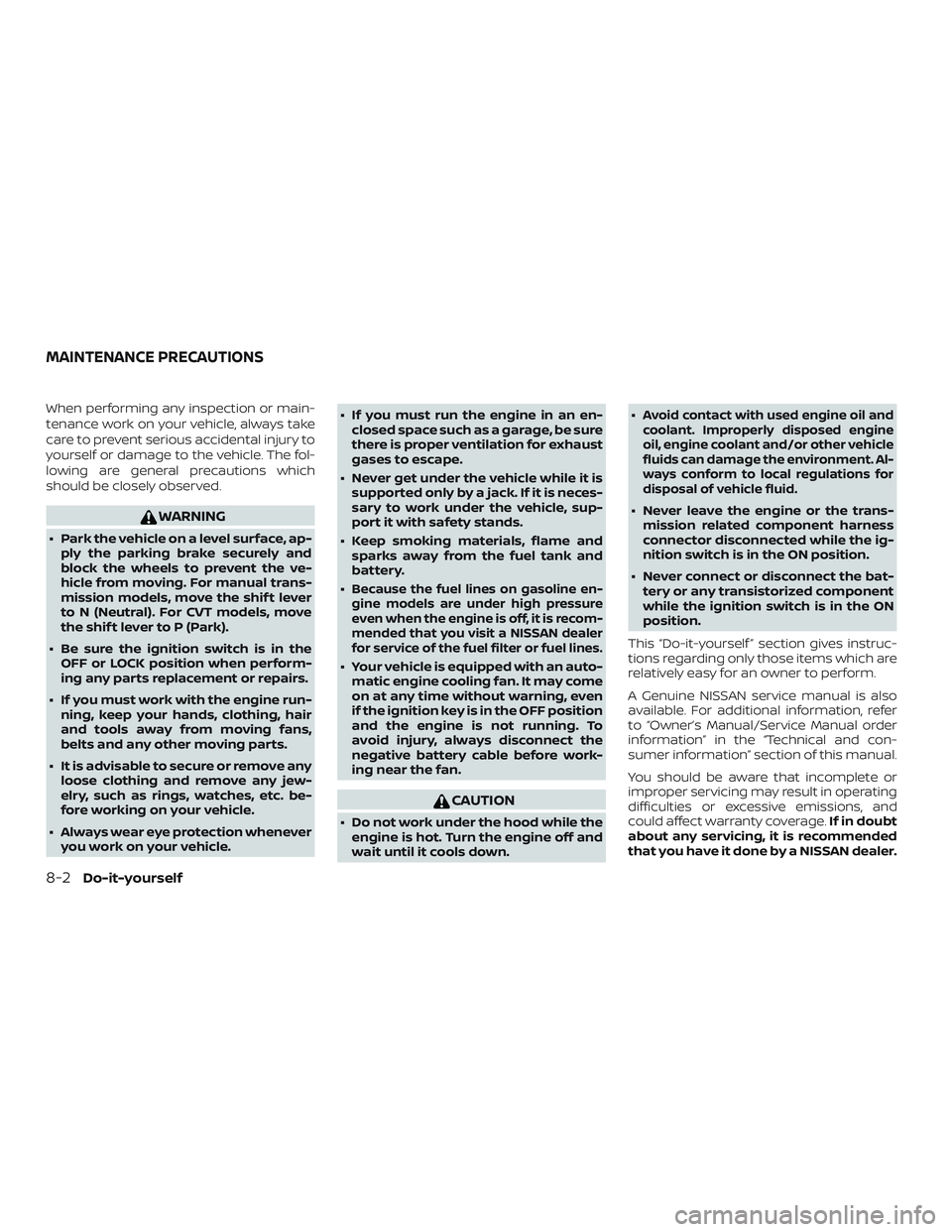2018 NISSAN VERSA SEDAN fuel pressure
[x] Cancel search: fuel pressurePage 501 of 702

REARVIEW MONITOR SYSTEM
LIMITATIONS
WARNING
Listed below are the system limitations
for RearView Monitor. Failure to operate
the vehicle in accordance with these
system limitations could result in seri-
ous injury or death.
∙ The system cannot completely elimi-nate blind spots and may not show
every object.
∙ Underneath the bumper and the cor- ner areas of the bumper cannot be
viewed on the RearView Monitor be-
cause of its monitoring range limita-
tion. The system will not show small
objects below the bumper, and may
not show objects close to the bumper
or on the ground.
∙ Objects viewed in the RearView Moni- tor differ from actual distance be-
cause a wide-angle lens is used.
∙ Objects in the RearView Monitor will appear visually opposite compared to
when viewed in the rearview and out-
side mirrors. ∙ Use the displayed lines as a reference.
The lines are highly affected by the
number of occupants, fuel level, ve-
hicle position, road conditions and
road grade.
∙ Make sure that the trunk is securely closed when backing up.
∙ Do not put anything on the rearview camera. The rearview camera is in-
stalled above the license plate.
∙ When washing the vehicle with high pressure water, be sure not to spray it
around the camera. Otherwise, water
may enter the camera unit causing
water condensation on the lens, a
malfunction, fire or an electric shock.
∙ Do not strike the camera. It is a preci- sion instrument. Otherwise, it may
malfunction or cause damage result-
ing in a fire or an electric shock.
The following are operating limitations and
do not represent a system malfunction: ∙ When the temperature is extremely high or low, the screen may not clearly
display objects. ∙ When strong light directly shines on the
camera, objects may not be displayed
clearly.
∙ Vertical lines may be seen in objects on the screen. This is due to strong re-
flected light from the bumper.
∙ The screen may flicker under fluores- cent light.
∙ The colors of objects on the RearView Monitor may differ somewhat from the
actual color of objects.
∙ Objects on the monitor may not be clear in a dark environment.
∙ There may be a delay when switching between views.
∙ If dirt, rain or snow accumulate on the camera, RearView Monitor may not dis-
play objects clearly. Clean the camera.
∙ Do not use wax on the camera lens. Wipe off any wax with a clean cloth
dampened with a diluted mild cleaning
agent, then wipe with a dry cloth.
Display screen, heater, air conditioner, audio and phone systems4-13
Page 555 of 702

5 Starting and driving
Precautions when starting and driving..........5-2
Exhaust gas (carbon monoxide) ..............5-2
Three-way catalyst ...........................5-2
Tire Pressure Monitoring System
(TPMS)........................................5-3
Avoiding collision and rollover ................5-6
Off-roadrecovery ............................5-6
Rapid air pressure loss .......................5-7
Drinking alcohol/drugs and driving ...........5-8
Ignition switch ...................................5-8
Continuously Variable Transmission (if
so equipped) .................................5-8
Manual transmission (if so equipped) .........5-9
Ignition switch positions ......................5-9
Before starting the engine ......................5-10
Starting the engine ............................. 5-10
Driving the vehicle ............................... 5-11
Continuously Variable Transmission
(CVT) (if so equipped) ......................... 5-11
Manual transmission (if so equipped) ........5-16
Parking brake .................................. 5-18
Cruise control (if so equipped) ..................5-19Precautions on cruise control
................5-19
Cruise control operations ....................5-19
Break-in schedule .............................. 5-21
Fuel efficient driving tips ........................5-21
Increasing fuel economy .......................5-22
Parking/parking on hills ........................5-23
Power steering ................................. 5-24
Brake system ................................... 5-25
Brake precautions ........................... 5-25
Anti-lock Braking System (ABS) ..............5-25
Brake Assist ................................. 5-26
Vehicle Dynamic Control (VDC) system .........5-27
Brake force distribution ......................5-28
Cold weather driving ........................... 5-29
Freeing a frozen door lock ...................5-29
Antifreeze ................................... 5-29
Battery...................................... 5-29
Draining of coolant water ....................5-30
Tire equipment .............................. 5-30
Special
winter equipment ...................5-30
Driving on snow or ice .......................5-30
Engine block heater (if so equipped) .........5-31
Page 557 of 702

CAUTION
∙ Do not use leaded gasoline. Depositsfrom leaded gasoline will seriously re-
duce the three-way catalyst’s ability
to help reduce exhaust pollutants.
∙ Keep your engine tuned up. Malfunc- tions in the ignition, fuel injection, or
electrical systems can cause overrich
fuel flow into the three-way catalyst,
causing it to overheat. Do not keep
driving if the engine misfires, or if no-
ticeable loss of performance or other
unusual operating conditions are de-
tected. Have the vehicle inspected
promptly. It is recommended that you
visit a NISSAN dealer for this service.
∙ Avoid driving with an extremely low fuel level. Running out of fuel could
cause the engine to misfire, damag-
ing the three-way catalyst.
∙ Do not race the engine while warming it up.
∙ Do not push or tow your vehicle to start the engine.
TIRE PRESSURE MONITORING
SYSTEM (TPMS)
Each tire, including the spare (if provided),
should be checked monthly when cold and
inflated to the inflation pressure recom-
mended by the vehicle manufacturer on
the vehicle placard or tire inflation pressure
label. (If your vehicle has tires of a different
size than the size indicated on the vehicle
placard or tire inflation pressure label, you
should determine the proper tire inflation
pressure for those tires.)
As an added safety feature, your vehicle
has been equipped with a Tire Pressure
Monitoring System (TPMS) that illuminates
a low tire pressure telltale when one or
more of your tires is significantly under-
inflated. Accordingly, when the low tire
pressure telltale illuminates, you should
stop and check your tires as soon as pos-
sible, and inflate them to the proper pres-
sure. Driving on a significantly under-
inflated tire causes the tire to overheat and
can lead to tire failure. Under-inflation also
reduces fuel efficiency and tire tread life,
and may affect the vehicle’s handling and
stopping ability. Please note that the TPMS is not a substi-
tute for proper tire maintenance, and it is
the driver’s responsibility to maintain cor-
rect tire pressure, even if under-inflation
has not reached the level to trigger illumi-
nation of the TPMS low tire pressure telltale.
Your vehicle has also been equipped with a
TPMS malfunction indicator to indicate
when the system is not operating properly.
The TPMS malfunction indicator is com-
bined with the low tire pressure telltale.
When the system detects a malfunction,
the telltale will flash for approximately one
minute and then remain continuously illu-
minated. This sequence will continue upon
subsequent vehicle start-ups as long as
the malfunction exists. When the malfunc-
tion indicator is illuminated, the system
may not be able to detect or signal low tire
pressure as intended. TPMS malfunctions
may occur for a variety of reasons, includ-
ing the installation of replacement or alter-
nate tires or wheels on the vehicle that
prevent the TPMS from functioning prop-
erly. Always check the TPMS malfunction
telltale af ter replacing one or more tires or
wheels on your vehicle to ensure that the
replacement or alternate tires and wheels
allow the TPMS to continue to function
properly.
Starting and driving5-3
Page 576 of 702

5.Use Cruise Control
∙ Using cruise control during highway driving helps maintain a steady
speed.
∙ Cruise control is particularly effective in providing fuel savings when driving
on flat terrains.
6. Plan for the Shortest Route
∙ Utilize a map or navigation system to determine the best route to save
time.
7. Avoid Idling
∙ Shutting off your engine when safe for stops exceeding 30–60 seconds
saves fuel and reduces emissions.
8. Buy an Automated Pass for Toll
Roads
∙ Automated passes permit drivers to use special lanes to maintain cruis-
ing speed through the toll and avoid
stopping and starting. 9.
Winter Warm Up
∙ Limit idling time to minimize impact to fuel economy.
∙ Vehicles typically need no more than 30 seconds of idling at start-up to
effectively circulate the engine oil be-
fore driving.
∙ Your vehicle will reach its ideal oper- ating temperature more quickly
while driving versus idling.
10. Keeping your Vehicle Cool
∙ Park your vehicle in a covered parking area or in the shade whenever pos-
sible.
∙ When entering a hot vehicle, opening the windows will help to reduce the
inside temperature faster, resulting in
reduced demand on your A/C sys-
tem. ∙ Keep your engine tuned up.
∙ Follow the recommended scheduled
maintenance.
∙ Keep the tires inflated to the correct pressure. Low tire pressure increases
tire wear and lowers fuel economy.
∙ Keep the wheels in correct alignment. Improper alignment increases tire wear
and lowers fuel economy.
∙ Use the recommended viscosity engine oil. For additional information, refer to
“Engine oil and oil filter recommenda-
tions” in the “Technical and consumer
information” section of this manual.
INCREASING FUEL ECONOMY
5-22Starting and driving
Page 612 of 702

When performing any inspection or main-
tenance work on your vehicle, always take
care to prevent serious accidental injury to
yourself or damage to the vehicle. The fol-
lowing are general precautions which
should be closely observed.
WARNING
∙ Park the vehicle on a level surface, ap-ply the parking brake securely and
block the wheels to prevent the ve-
hicle from moving. For manual trans-
mission models, move the shif t lever
to N (Neutral). For CVT models, move
the shif t lever to P (Park).
∙ Be sure the ignition switch is in the OFF or LOCK position when perform-
ing any parts replacement or repairs.
∙ If you must work with the engine run- ning, keep your hands, clothing, hair
and tools away from moving fans,
belts and any other moving parts.
∙ It is advisable to secure or remove any loose clothing and remove any jew-
elry, such as rings, watches, etc. be-
fore working on your vehicle.
∙ Always wear eye protection whenever you work on your vehicle. ∙ If you must run the engine in an en-
closed space such as a garage, be sure
there is proper ventilation for exhaust
gases to escape.
∙ Never get under the vehicle while it is supported only by a jack. If it is neces-
sary to work under the vehicle, sup-
port it with safety stands.
∙ Keep smoking materials, flame and sparks away from the fuel tank and
battery.
∙
Because the fuel lines on gasoline en-
gine models are under high pressure
even when the engine is off, it is recom-
mended that you visit a NISSAN dealer
for service of the fuel filter or fuel lines.
∙ Your vehicle is equipped with an auto- matic engine cooling fan. It may come
on at any time without warning, even
if the ignition key is in the OFF position
and the engine is not running. To
avoid injury, always disconnect the
negative battery cable before work-
ing near the fan.
CAUTION
∙ Do not work under the hood while theengine is hot. Turn the engine off and
wait until it cools down. ∙
Avoid contact with used engine oil and
coolant. Improperly disposed engine
oil, engine coolant and/or other vehicle
fluids can damage the environment. Al-
ways conform to local regulations for
disposal of vehicle fluid.
∙ Never leave the engine or the trans- mission related component harness
connector disconnected while the ig-
nition switch is in the ON position.
∙ Never connect or disconnect the bat- tery or any transistorized component
while the ignition switch is in the ON
position.
This “Do-it-yourself ” section gives instruc-
tions regarding only those items which are
relatively easy for an owner to perform.
A Genuine NISSAN service manual is also
available. For additional information, refer
to “Owner’s Manual/Service Manual order
information” in the “Technical and con-
sumer information” section of this manual.
You should be aware that incomplete or
improper servicing may result in operating
difficulties or excessive emissions, and
could affect warranty coverage. If in doubt
about any servicing, it is recommended
that you have it done by a NISSAN dealer.
MAINTENANCE PRECAUTIONS
8-2Do-it-yourself
Page 690 of 702

LATCH (Lower Anchors and Tethers for
CHildren)System..............1-23
Precautions on child
restraints .........1-20, 1-27, 1-33, 1-38
Top tether strap anchor point
locations.................. .1-25
Child safety rear door lock ..........3-6
Chimes, audible reminders .........2-20
Cleaningexteriorandinterior......7-2,7-4
Clockset.....................4-5
Clutch Clutchfluid.................8-10
Coldweatherdriving.............5-29
Continuously Variable Transmission
(CVT) .....................5-8,5-11
Continuously Variable Transmission
(CVT) fluid ...................8-9
Driving with Continuously Variable
Transmission (CVT) ..........5-8,5-11
Control panel buttons .............4-2
Brightness/contrast button .......4-7
Controls Audio controls (steering wheel) .....4-43
Heater and air conditioner controls . .4-15
Coolant Capacities and recommended
fuel/lubricants...............10-2
Changing engine coolant .........8-5
Checking engine coolant level ......8-5
Engine coolant temperature gauge . .2-9
Corrosionprotection..............7-7
Cruisecontrol..................5-19
Cupholders...................2-29
Curtain side-impact and rollover air
bag....................... .1-57D
Defroster switch Rearwindowdefrosterswitch.....2-22
Dimensions and weights ..........10-10
Dimmer switch for instrument panel . . .2-24
Display controls
(see control panel buttons) ..........4-2
Door locks ....................3-4
Door open warning light ...........2-14
Drivebelt ....................8-14
Driving Cold weather driving ...........5-29
Driving with Continuously Variable
Transmission (CVT) ..........5-8,5-11
Driving with manual
transmission ..............5-9,5-16
Precautions when starting and
driving.....................5-2
Drivingthevehicle...............5-11
E
Economy - fuel .................5-22
Emission control information label . . . .10-12
Emission control system warranty . . . .10-19
Engine Before starting the engine ........5-10
Blockheater ................5-31
Capacities and recommended
fuel/lubricants...............10-2
Changing engine coolant .........8-5
Changing engine oil ............8-7
Changing engine oil filter .........8-8
Checking engine coolant level ......8-5Checking engine oil level
.........8-6
Engine compartment check
locations...................8-3
Engine coolant temperature gauge . .2-9
Engine cooling system ..........8-4
Engine oil ...................8-6
Engine oil and oil filter
recommendation .............10-7
Engine oil pressure warning light ....2-14
Engine oil viscosity .............10-7
Engine serial number ..........10-12
Engine specifications ...........10-9
Starting the engine ............5-10
Engine coolant temperature gauge ....2-9
EventDatarecorders ............10-21
Exhaust gas (Carbon monoxide) .......5-2
Explanation of maintenance items .....9-2
Explanation of scheduled maintenance
items .......................9-5
Extended storage switch ..........8-20
F
Flashers
(Seehazardwarningflasherswitch)....6-2
F
lattire....................6-2,6-3
Floormatpositioningaid...........7-6
Fluid Brakefluid..................8-9
Capacities and recommended
fuel/lubricants...............10-2
Clutchfluid.................8-10
Continuously Variable Transmission (CVT)
fluid......................8-9
Engine coolant ...............8-4
11-2
Page 692 of 702

Charge warning light...........2-14
ExteriorandInteriorlights........8-24
Foglights..................8-24
Foglightswitch..............2-25
Headlight and turn signal switch ....2-22
Headlightcontrolswitch.........2-22
Headlights .................8-22
Interiorlight .............2-32,2-33
Lightbulbs.................8-22
Low tire pressure warning light .....2-15
Passenger air bag and status light . . .1-51
Trunklight..................2-34
Warning/indicator lights and audible
reminders ..................2-18
Lights ......................8-22
Lock Child safety rear door lock ........3-6
Door locks ..................3-4
Fuel-filler door lock opener lever ....3-14
Power door locks ..............3-5
Trunk lid lock opener lever ........3-12
Loose fuel cap warning ............2-7
Lowfuelwarninglight ............2-15
Low tire pressure warning light .......2-15
Luggage
(See vehicle loading information) .....10-14
M
Maintenance General maintenance ...........9-2
Insidethevehicle..............9-3
Maintenance precautions .........8-2
Outsidethevehicle.............9-2
Seat belt maintenance ..........1-17 Under the hood and vehicle
.......9-4
Maintenance log ................9-13
Maintenance requirements ..........9-2
Maintenance schedules ............9-7
Maintenance under severe operation
conditions....................9-12
Malfunctionindicatorlight..........2-18
Manual front seat adjustment ........1-3
Manual windows ................2-32
Menu button ...................4-5
Meters and gauges ...............2-3
Instrument brightness control .....2-24
Mirror Outsidemirrorcontrol..........3-18
Outsidemirrors ..............3-18
Rearview...................3-18
Vanitymirror ................3-17
Mirrors......................3-18
O
Octane rating (See fuel octane rating) . .10-6
Odometer ....................2-6
Oil Capacities and recommended
fuel/lubricants...............10-2
Changing engine oil ............8-7
Changing engine oil filter .........8-8
Checking engine oil level .........8-6
Engine oil ...................8-6
Engine oil and oil filter
recommendation .............10-7
Engine oil viscosity .............10-7
One shot call ..................4-50
Outsidemirrorcontrol............3-18 Outsidemirrors ................3-18
Overheat
Ifyourvehicleoverheats.........6-11
Owner's manual order form ........10-22
Owner's manual/service manual order
information..................10-22
P
Parking Parking brake operation .........5-18
Parking/parkingonhills.........5-23
Parkingbrake..................5-18
Phone, Bluetooth® hands-free system . .4-47
Power Power door locks ..............3-5
Poweroutlet................2-26
Power steering system ..........5-24
Powerwindows..............2-30
Rearpowerwindows...........2-31
Poweroutlet..................2-26
Powersteering.................5-24
Precautions Maintenance precautions .........8-2
Precautions on booster
seats............1-20, 1-27, 1-33, 1-38
Precautions on child
r
estraints .........1-20, 1-27, 1-33, 1-38
Precautionsonseatbeltusage.....1-10
Precautions on supplemental restraint
system ....................1-42
Precautions when starting and
driving .....................5-2
Programmable features ............4-5
Push starting ..................6-11
11-4
Page 694 of 702

Power door lock switch..........3-5
Rearwindowdefrosterswitch.....2-22
Turn signal switch .............2-24
T
Tachometer ...................2-8
Temperature gauge Engine coolant temperature gauge . .2-9
Three-waycatalyst...............5-2
Tilting steering wheel .............3-16
Tire Flattire..................6-2,6-3
Spare tire ...............6-4,8-38
Tire and Loading Information label . .10-13
Tire chains .................8-35
Tire pressure ................8-28
Tirerotation ................8-36
Types of tires ................8-34
Uniform tire quality grading ......10-18
Wheels and tires ..........8-28,10-10
Wheel/tire size ...............10-10
Tire pressure Low tire pressure warning light .....2-15
Tire Pressure Monitoring System (TPMS) . .5-3
Towing 2-wheel drive models ...........6-14
4-wheel drive models ...........6-13
Flattowing.................10-18
Towtrucktowing .............6-12
Trailertowing...............10-18
Towingatrailer................10-18
Transmission Continuously Variable Transmission (CVT)
fluid......................8-9 Driving with Continuously Variable
Transmission (CVT)
..........5-8,5-11
Driving with manual
transmission ..............5-9,5-16
Travel (See registering a vehicle in another
country) .....................10-11
Trip computer .................2-10
Trip odometer ...............2-5,2-6
Trunk lid lock opener lever ..........3-12
Trunklight....................2-34
Turn signal switch ...............2-24
U
Uniform tire quality grading ........10-18
USBinterface..................4-33
V
Vanitymirror ..................3-17
Variablevoltagecontrolsystem......8-13
Vehicle dimensions and weights .....10-10
Vehicle Dynamic Control (VDC) OFF
switch......................2-26
Vehicle dynamic control (VDC) system . .5-27
Vehicle Dynamic Control (VDC) system . .5-27
Vehicle identification .............10-11
Vehicle identification number (VIN) . . . .10-11
Vehicle identification number (VIN)
(Chassis number) ...............10-11
Vehicle identification number (VIN)
plate.......................10-11
Vehicle loading information ........10-14
Vehiclerecovery................6-14 Ventilators
....................4-14
Visors.......................3-17
Voice Prompt Interrupt ............4-50
W
Warning Airbagwarninglight........1-60, 2-17
Anti-lock brake warning light ......2-13
Battery charge warning light ......2-14
Brakewarninglight............2-13
Door open warning light .........2-14
Engine oil pressure warning light ....2-14
Hazard warning flasher switch ......6-2
Loosefuelcapwarning..........2-7
Lowfuelwarninglight ..........2-15
Low tire pressure warning light .....2-15
Passenger air bag and status light . . .1-51
Seatbeltwarninglight .......1-13, 2-17
Supplemental air bag warning
light.................. .1-60, 2-17
Warning/indicator lights and audible
reminders ..................2-18
Warning labels (for SRS) ..........1-59
W
arning/indicator lights and audible
reminders ....................2-18
Audible reminders .............2-18
Indicatorlights...............2-18
Warninglights ...............2-18
Warninglights .................2-18
Warning lights, indicator lights and audible
reminders ....................2-12
Weights
(See dimensions and weights) .......10-10
Wheels and tires ............8-28,10-10
11-6